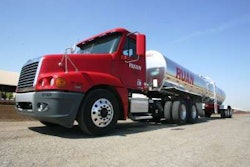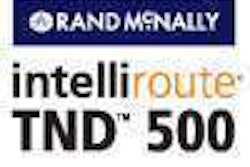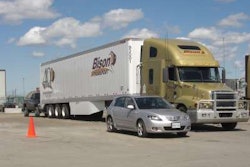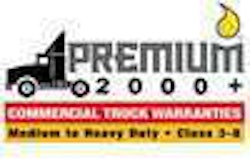Navistar defends choice of advanced EGR
Regardless of what path you take to 2010 emissions compliance, it appears you will pay significantly more for the truck. Except for Paccar, which hasn’t announced pricing yet, the truck manufacturers that will rely on selective catalytic reduction (SCR) to reduce NOx from engines have disclosed price increases ranging from $9,000 to $9,800 due to U.S.
Environmental Protection Agency emissions regulations. And Navistar – the lone manufacturer relying solely on advanced exhaust gas recirculation (EGR) – announced that prices for its Class 8 trucks will rise by almost as much due to the steps needed to comply with emissions.
Prices for International trucks equipped with MaxxForce 11 and 13 big bore advanced EGR diesel engines will increase $8,000 with next year’s emissions-mandated change, while prices for trucks equipped with the MaxxForce 7, DT, 9 and 10 will increase $6,000, Navistar said. Increases will come in the form of a nondiscountable surcharge applied to each vehicle’s base price.
“Meeting stricter EPA emissions levels in 2010, unfortunately, comes with a higher price,” said Jack Allen, president of Navistar’s North American Truck Group. “Though we have given our best effort to minimize costs related to the robust design and development of 2010 MaxxForce engines to ensure pricing is manageable for our customers, prices will increase commensurate with our technology path and our effort to remain competitive in the marketplace.” Navistar says its MaxxForce advanced EGR engines feature advancements in fuel injection, improved air intake management, improved electronic calibration and proprietary combustion technology.
Last month, Daimler Trucks North America announced pricing for meeting 2010 standards with its Detroit Diesel BlueTec or Cummins midrange engine emissions technologies. Emissions technology surcharges for vehicles equipped with Detroit Diesel DD15 and DD16 big bore engines, as well as the medium bore DD13, will be $9,000 per vehicle. A surcharge of $7,300 will be added to vehicles equipped with the Cummins ISC8.3 engine, and a $6,700 surcharge will be added to the price of vehicles equipped with Cummins ISB6.7 engines.
Volvo and Mack – both of which will use SCR aftertreatment – already had disclosed emissions-related price increases. Volvo will add $9,600 to truck prices for 2010 trucks; Mack’s price increases will be $9,600 to $9,800.
SCR technology consists of an aftertreatment catalyst system that allows engine exhaust to be treated with diesel exhaust fluid (DEF) that reduces NOx into nitrogen and water.
Customers evaluating BlueTec-equipped 2010 test engines report up to a 5 percent increase in mpg, said Mark Lampert, senior vice president of sales for Daimler Trucks North America. “We feel strongly that providing our customers with payback in the form of significant improvement in fuel economy is of fundamental importance and an appropriate return on their investment in 2010 technology.”
Daimler says Detroit Diesel BlueTec fuel efficiencies are the result of three optimization factors: base engine-out NOx levels, diesel particulate filter (DPF) regeneration intervals and exhaust back pressure. In addition, reduced reliance on EGR lowers heat rejection, meaning no expansion of cooling capacity and no resulting impact on aerodynamics or underhood packaging.
Defending EGR
While Navistar’s emissions-related upcharge isn’t dramatically lower than that of its SCR competitors, the company argues that the acquisition cost with its advanced EGR solution is the only additional cost that customers will incur. There’s no DEF to buy, additional systems to maintain or extra weight from DEF tanks and added components, Navistar says.
In a conference call with industry journalists on July 28, Allen responded to competitors’ claims of superior fuel economy, saying those claims are based solely on a Class 8 on-highway truck operating in optimal conditions. “Our competitors are focusing on Class 8 highway almost exclusively in developing their solutions and expressing the adequacy of their findings,” added Jim Hebe, senior vice president of the North American sales operation. In some vocational medium-duty vehicles, there will be improvements in fuel economy, Allen said, adding that fuel economy of the engine itself is only 35 to 40 percent of the total solution.
Allen also responded to some claims that advanced EGR would increase underhood temperatures and reduce engine durability and reliability. On the contrary, Navistar will be using a two-stage EGR cooler that will produce cooler air than the current engine, he said.
-Avery Vise
GM vows to support Kodiak, TopKick buyers
About 6,000 medium-duty trucks remain in inventory
Although General Motors ceased production of its medium-duty Kodiak and TopKick models in July as a response to the company’s recession-spurred bankruptcy proceedings and subsequent restructuring efforts, the company is assuring dealers and customers that it will continue to offer parts and service support for those trucks. Moreover, GM is still in the truck selling business, with GMC Truck and Chevrolet dealers still in place and an inventory of more than 6,000 new trucks, says Mark Karney, marketing director for General Motors’ medium-duty trucks.
“We have a strong dealer network that has been selling and servicing medium-duty trucks for years, and that network is still intact,” Karney notes. “Our customers have the peace of mind of knowing those dealers are there through our wind-down period that goes through mid-October 2010, and we are in the early stages of developing a service agreement that will provide further peace of mind for our customers beyond that date.”
The more than 6,000 trucks in stock are fully backed by GM warranty and fully supported by its dealer network, Karney says. “Our customers need to understand that they have our assurance that they will be able to get parts, service and support for the trucks they purchase for the life of that vehicle.”
Although GM won’t offer indefinite parts and service support, Karney says the company typically provides parts availability for up to 10 years even for models and products that are exiting a given market. “We will do our best to secure parts for our trucks for as long as we possibly can, while acknowledging that some of those parts come from outside vendors and suppliers.”
There is a chance that the Kodiak and TopKick brands could continue with another manufacturer, though the likelihood of that happening is unclear. “I do know there are outside parties that have expressed interest in the assets of the plants and the intellectual property behind the trucks themselves,” Karney says. Navistar and GM in late 2007 announced plans for Navistar to buy GM’s medium-duty business and market it through GM and Chevrolet dealers, but the deal formally fell apart about a year ago.
As for its continuing lighter-duty line, “we’re getting some anecdotal comments from our customers and our dealers that the light at the end of the tunnel is getting stronger and that everybody seems to think that we’re through the worst of the downturn,” Karney says.
– Jack Roberts
Wabash finalizes investment, credit deal
Trailer firm gains access to capital in tough economy
Wabash National Corp. said last month that it had closed on a previously announced $35 million investment in the company and a related amended revolving credit facility that provides for borrowing of up to $100 million. The investor is Trailer Investments LLC, an entity formed by Lincolnshire Equity Fund III L.P., a private equity investment fund managed by Lincolnshire Management Inc. As part of the deal, Wabash National issued preferred stock to Trailer Investments and a warrant representing 44.21 percent of the company’s common stock. Wabash National also increased the size of its board of directors to 12 members and appointed five designees of Trailer Investments.
“We are excited to welcome Trailer Investments as not only an investor in Wabash National but, more importantly, as our new partner,” said Dick Giromini, president and chief executive officer of Wabash National Corp. “Lincolnshire Management brings a proven track record of success and has consistently demonstrated a strong commitment to supporting the companies that they invest in.” The investment and amended credit facility, along with previous cost-restructuring initiatives, provide the capital structure to meet needs during the economic downturn and set the stage for profitable growth as business conditions improve, Giromini said.
“We are extremely pleased to have closed our investment in Wabash National and to provide the company with more operating flexibility during this economic downturn,” said Michael Lyons, senior managing director of Lincolnshire Management. “We look forward to working together with the management team to grow Wabash’s market-leading position and franchise.”
Continuing a relationship
Wabash National and Lincolnshire Management were hardly strangers before the current deal arose. In 2006, Wabash National bought Transcraft Corp., a leading flatbed and trailer manufacturer, from Lincolnshire Management, which had acquired the company in 1999 from its founder, William Cunningham. Lincolnshire already had built Transcraft’s market share through dealer expansion and other initiatives, and the acquisition by Wabash National gave Transcraft access to more development and process efficiency resources.
Transcraft’s product line at the time of its acquisition by Wabash National included steel and steel-aluminum trailers. Seeing the need for an all-aluminum product, Transcraft had been in the early stages of developing an aluminum product when it purchased certain assets of Benson International, a manufacturer of aluminum flatbed trailers and dump bodies, in July 2008. Benson is now a model name in the Transcraft portfolio.
Today, Transcraft Corp. is one of two wholly owned Wabash National subsidiaries. The other is Wabash National Trailer Centers – trailer service centers and retail distributors of new and used trailers and aftermarket parts throughout the United States.
– Avery Vise
Wabash offers aero trailer skirt
Wabash National Corp.’s DuraPlate Products Group (www.duraplateproducts.com) launched a new aerodynamic accessory for trailers that the company says has been shown through testing to improve fuel economy by 5.6 percent. Drawing on the same technology as Wabash’s DuraPlate composite panel, the DuraPlate AeroSkirt is designed to allow for inward and outward flex to reduce damage. The DuraPlate AeroSkirt is easy to install and can be attached to various model trailers, Wabash says.
“With over 360,000 DuraPlate trailers currently on the road, our DuraPlate panel technology continues to redefine the standard by which trailers are measured in terms of strength, durability and value,” says Rod Ehrlich, Wabash National’s chief technology officer.
The DuraPlate AeroSkirt has been approved by the U.S. Environmental Protection Agency’s SmartWay program, says Jamie Scarcelli, vice president and general manager of DuraPlate Products Group. That is important because regulations approved by the California Air Resources Board will require SmartWay-verified trailer aerodynamic devices on most model year 2011 long-haul dry and refrigerated van trailers operating within California beginning next year, and such devices would have to be retrofit on older trailers by 2012.
Peterbilt Motors Co. marks 70 years
T.A. Peterman first built trucks for his own lumber firm
In the late 1930s, T.A. Peterman’s Tacoma, Wash.-based lumber manufacturing company began building its own trucks for logging. In 1939, Peterman began selling trucks to the public, and Peterbilt Motors Co. was born. In late July, Peterbilt marked its 70th anniversary by bringing some of its leading dealers and customers to its headquarters in Denton, Texas, for ride-and-drives of today’s heavy-duty projects, technology presentations and a tour of the truck manufacturer’s Denton plant. Bill Jackson, Peterbilt general manager and Paccar vice president, capped the celebration with a cake cutting for plant employees and dignitaries.
“Since our first truck was produced in 1939, Peterbilt has become one of the most widely recognized and respected brands in the world – a universal symbol of pride, quality and class,” Jackson said.
In its first year, Peterbilt cranked out 14 trucks. Since then, the company has produced almost 700,000. The company isn’t sure who its first outside customer was, but its first dealer – San Jose, Calif.-based Coast Counties Truck and Equipment – began selling Peterbilt trucks in 1949 and still does so today. The Peterbilt dealer network is at an all-time high at 247 locations in North America.
Peterman died in 1945 and didn’t get to see his company become a major industry player. Peterbilt’s managers bought the company from Peterman’s widow, and they ultimately took the key step of selling out in 1958 to Paccar – a company that already had been in business for more than a half century and had the resources to develop Peterbilt’s product line and brand.
Nearly 100 model configurations have marked Peterbilt’s history, noted Larry Reding, assistant general manager of sales and marketing. “From the first logging trucks of the ’30s and revolutionary cabover vehicles in the ’40s, to the birth of an industry icon – the Model 359 in the ’60s – Peterbilts have set the pace,” Reding said. “In the ’70s and ’80s, the workhorses that built America were Peterbilt Models 348, 362 and the legendary Model 379.”
But while Peterbilt became known for its long-nose conventionals, the company continued to look at evolving customer needs. Starting especially with the Model 387 in 1999, Peterbilt launched several aerodynamic trucks aimed at further improvements in fuel efficiency and even added some aerodynamic tweaks to its long-nose conventionals. Today, the company offers three U.S. Environmental Protection Agency SmartWay-certified tractors – the 387, 386 and 384.
Improvements in aerodynamics, productivity and payload maximization have been a staple throughout company history, said Chief Engineer Landon Sproull. Peterbilt also has developed diesel-electric and diesel-hydraulic hybrid models in the medium- and heavy-duty markets.
– Avery Vise













